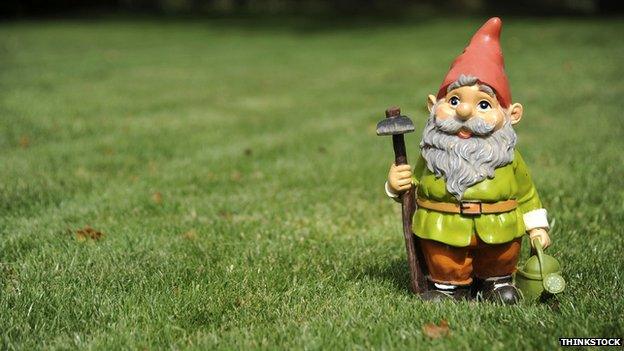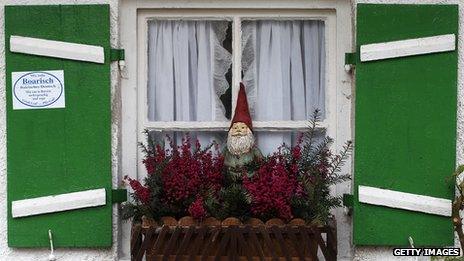Chelsea Flower Show: Our love-hate relationship with garden gnomes
- Published

The Royal Horticultural Society has temporarily lifted a ban on garden gnomes - normally deemed too "tacky" - at the Chelsea Flower Show. Garden historian Twigs Way charts the public's long love-hate relationship with these figurines.
History is full of curious tales - and none more so than the simple garden gnome.
Alternately loved and loathed, the gnome epitomises the social divisiveness of garden design. Snobbery may dictate a gnome free home, but for some a pond will never be complete without a cheery chap in a pointed red hat and a fishing rod.
The idea of including small stone figures in the garden is an ancient one.
Priapus, the ancient phallic god of fertility inhabited many a Roman garden, resembling the naughtier gnomes of the modern day, while during the Renaissance period, gardens of wealthy villas sported groups of stone "grotesques" including Punch-style figures typically a metre tall and garishly painted.
In Germany the history of these garden figures has become inextricably confused with the tradition of "little folk" or dwarves who were believed to help in the mines and around the farm. The belief took hold that a stone or even wooden image of a dwarf might be placed in a house or garden to bring luck.
As the first proud Germanic dwarves arrived in England they were promptly re-named as the more humble "gnome".
The manufacturing heartland of the early gnome or dwarf centred on the town of Graefenroda in Germany. Here clustered the famous companies of, Heissner, Griebel and Romeiss with the equally famous Maresch factories based near Dresden.
Skilled workers in these "Gartenzwergmanufacturs" (zwerg being the German for "dwarf") moulded 3ft (1m) tall figures in terracotta and ceramic mixes, with carefully detailed and hand-painted features. A subsidiary trade grew up in smaller porcelain models mainly suited for indoor use.
Who brought the first gnome to England will probably never be proven, but the first to record using the figures in his garden was Charles Isham at Lamport Hall in Northamptonshire who by the 1870s had a series of gnome tableaux in among his giant rock garden.
"Lampy", the sole survivor of the once numerous Lamport gnomes, now lays claim to being the oldest garden gnome in England and regularly attends gnome conferences around the world, with a suitably high holiday insurance of £1m.
Sir Frank Crisp at Friar Park in Oxfordshire was another early adopter, with his grand country house garden housing several of the 1m-tall gnomes by the late 1890s.

The reputation of the Germanic gnome plummeted after World War I
It was Sir Frank's gnomes that featured so prominently on the cover of the George Harrison album All Things Must Pass.
In the first decade of the 20th Century gnomes became popular and high status features of country house gardens and venerable vicarages, and even appeared on stands at the 1912 International Horticultural Exhibition - precursor to modern day Chelsea show.
Sir Frank was himself awarded the Victoria Medal of the Royal Horticultural Society in 1919, although the RHS was notably quiet on the subject of his gnomes.
With the outbreak of World War I the reputation of the Germanic gnome plummeted. It was left to Disney to revive the fashion with their hit animation film Snow White and the Seven Dwarfs. So came the heyday of the traditional concrete garden gnome.
.jpg)
Risque models in gnome capital Graefenroda
British companies, such as the one owned by the father of the future Prime Minister John Major, built their success on the gnome trade. Soon even the humblest suburban garden boasted a full set of Sleepy, Snoozy and Droopy, et al.
In the 1970s a whole new gardening generation rushed to buy multi-coloured plastic gnomes dressed in football strips, beachwear and even disguised as Smurfs. Solar driven gnomes whistled and farted, and "naughty gnomes" boasted areas of the gnomish anatomy that Priapus would have been proud of.
Perhaps not unconnected with the spread of gnomish undress, the late 20th Century also saw the much awaited arrival of the female gnome.
Fashion is a fickle mistress and a hundred years after they were last seen at the "Chelsea" of the day, gnomes from round the country are yet again heading back to the sacred showground of all things horticultural, fishing rods, toadstools and of course, gardening spades, packed and at the ready!
Dr Twigs Way is the author of Garden Gnomes: A History
You can follow the Magazine on Twitter, external and on Facebook, external